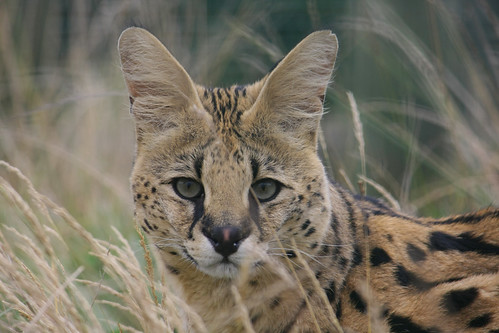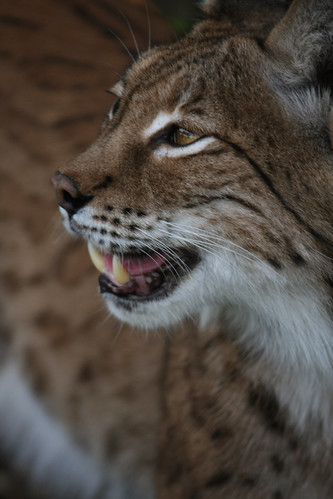In today’s blog I will be continuing with my visit to the Wildlife Heritage Foundation and the Big Cats photography day I attended there last weekend.
The next cat we met was Malawai who is a Serval. These smaller cats live mostly in South Africa, they have bold markings, long legs and tall oval ears. Avid hunters they use their ears to detect rodents even those which are burying underground, their long legs allow them to see over the top of tall grasses.
 When hunting Servals will sometimes pause for up to 15 minutes with their eyes closed, they can jump almost 10 feet off the ground and can quite often be found catching passing birds. We were told by the keeper that Malawai kills anything which gets into his enclosure from mice and rats to low flying or birds resting in the shrubbery – basically if you are a small animal which gets in this guys pen your lucky to get out alive!
When hunting Servals will sometimes pause for up to 15 minutes with their eyes closed, they can jump almost 10 feet off the ground and can quite often be found catching passing birds. We were told by the keeper that Malawai kills anything which gets into his enclosure from mice and rats to low flying or birds resting in the shrubbery – basically if you are a small animal which gets in this guys pen your lucky to get out alive!
The biggest threat for Servals in the wild are humans who hunt them for their coats which are then sold as young leopard or cheetah coats, however they can survive well in the presence of humans and are sometimes tolerated and encouraged to live near farms as they help keep the rodent population under control.
We then had a break for lunch so a chance to take the pictures I had already taken off my memory card just in case anything happened to them and also to give me some more space for the afternoons antics as I knew we still had plenty more cats to see.
The first cats we saw in the afternoon were the Cheetahs, Pepo and Mephisto two males who live in separate enclosures. Pepo is the older of the two at 9 years old and was a successful member of the breeding programme having fathered 10 offspring he is now retired and will remain at the WHF.

Mephisto is four years old and was born at Safari de Peaugres in France he came to the WHF in January 2008 after an attempt at getting him to be a partner to a Cheetah at Paradise Wildlife Park failed, possibly as he is still quite young. He was bought to the centre to try and mature and learn something about Cheetah life from Pepo. Mephisto is nervous of everything on the site including the ducks on a pond next to his enclosure.
Pepo’s favourite pastimes include relaxing in the sun and chasing the trains which pass the site of the adjacent railway line – he did this a few times while we were there and it showed just how quickly these cats can run.
Cheetahs aren’t as endangered as some of the other cats at the centre but still work is being done to get the captive animals breeding so that some of them can hopefully be released back into the wild. Now it’s off to see the newest additions to the WHF the pumas.
Valentina and Viktoria are two sisters that came to the centre in September 2008, they are settling in really well to their specially adapted enclosure. Pumas are also known as Cougars or Mountain Lions, they can differ in colour and size and can be found in a variety of habitats from mountain forests to swamps and grasslands. Valentina is the more shy of the two Pumas at the WHF choosing to stay out of the way for most of our visit and hiding behind some of the cubby holes that have been created for the cats to sit under in their enclosure.
 Pumas usually hunt alone and will stockpile their food if large enough in dense undergrowth, returning back to it over several days. They are a similar size to a Leopard and can easily catch prey as large as a cow or a horse due to their powerful and muscular bodies. In the wild when hunting the Puma uses it powerful hind legs to lunge at its prey and can jump in excess of 40 feet. Viktoria was especially good at demonstrating this by jumping for us a number of times in her enclosure to catch her food.
Pumas usually hunt alone and will stockpile their food if large enough in dense undergrowth, returning back to it over several days. They are a similar size to a Leopard and can easily catch prey as large as a cow or a horse due to their powerful and muscular bodies. In the wild when hunting the Puma uses it powerful hind legs to lunge at its prey and can jump in excess of 40 feet. Viktoria was especially good at demonstrating this by jumping for us a number of times in her enclosure to catch her food.
Numbers of Pumas living in the wild are most at risk from hunting and trapping by humans which is unfortunately the case with a lot of these big cats. This is one of the things that saddens me about the human race is that it seems intent on destroying everything beautiful about our planet.
After meeting Viktoria and Valentina we were taken to meet Petra the resident Lynx. A medium sized cat who is very powerful she starred in a children’s TV programme called “Brilliant Creatures”

Petra is a very intelligent cat and is always ready to play games with her keepers, she is able to jump 4 metres in the air to grab a piece of meat from the end of a pole. In the wild Lynxes would live in a wide ranging area from the Southern European Coast to the Artic Circle, their big feet and long legs mean they are adapted to travel through deep snow.
In some areas the Lynx is a protected species however in other areas they are hunted for the legal fur trade. The Lynx is also sometimes killed by farmers as if food is scarce they will take farm animals to feed on. In harsh winters the loss of animals for the Lynx to prey on can also cause a problem to the species. Petra doesn’t have to worry about this as she tucks into her tasty pigeon…..

Lastly on today’s blog are the Snow Leopards. By this time the sun had come out and was blazing away, it was absolutely sweltering and a lot of the cats were taking shade to keep cool and having a little afternoon siesta and the two Snow Leopards Ranschan and Mizi were no exception.
Mizi was having a snooze up on her treetop platform and even some fresh chunks of meat couldn’t tempt her down so while everyone else was concentrating on the keeper trying to get Mizi down to the ground I spotted Ranschan in his enclosure wide awake and headed off to get some shots of him. He was obviously quite sleepy but he did pull the cutest pose ever for me.

These leopards would usually be found in some of the world´s most remote habitats, ranging from China, Nepal, India, Kazakstan, Mongolia and the Gobi dessert. A protected species, numbers are estimated to be between 3,500 to some 7,000, due to the cats elusive secretive nature, their classed as endangered animals on the Worlds Conservation list.
It was so hard looking at some of these animals to believe that they had the inclination and the ability to kill but if I needed any kind of reminder it was from this moment when Ranschan decided to show me the size of his teeth!

I’m sure that his dentist bill isn’t cheap with those huge incisors!
Well I think that’s enough for today, I still have one more animal to tell you about and a lovely story from my day but I‘ll leave those till next time but I hope you have enjoyed todays post.
P lease if you have taken the time to read this then leave a comment it only takes a couple of seconds to do and they are all most appreciated.
Great pictures Sharon! The focus is so sharp and I love they way you captured their eyes. The pouncing puma, wow! The stories about the cats are wonderful. I was just reading about a sanctuary in the states that rescues abused exotic animals, they have a number of big cats. http://www.cedrhill.org/
ReplyDeleteI've tried to give a bit of info on the cats rather than just posting pictures with no explanation. I like telling a little story alongside them.
ReplyDeleteCedarhill looks like an amazing place - how people can hurt these animals is beyond me.
I have written up the final installment of my visit to the big cat sanctuary now and it's on my page.
Thank you for reading my blog it is most appreciated.
What a very cool opportunity to photograph these amazing cats. That one of the puma leaping is absolutely terrifiying...I'm always thinking about them jumping down from cliffs and trees, eating hikers like myself. I hear about that on the news at least once a year in the Colorado/Wyoming area. It's sad evidence of human encroachment into wild areas and unchecked development.
ReplyDelete